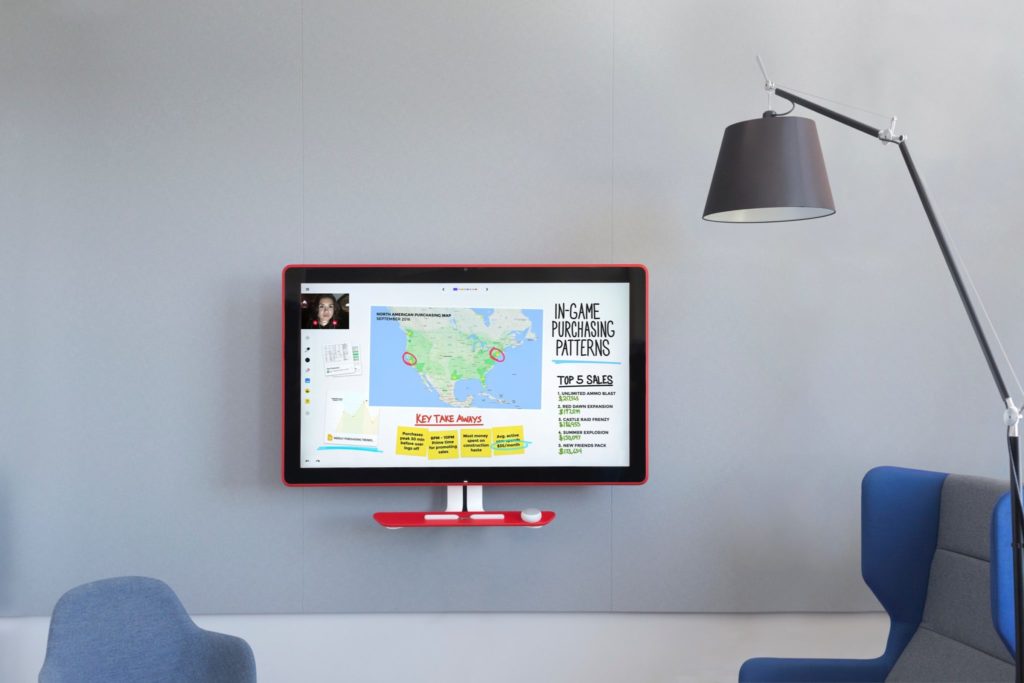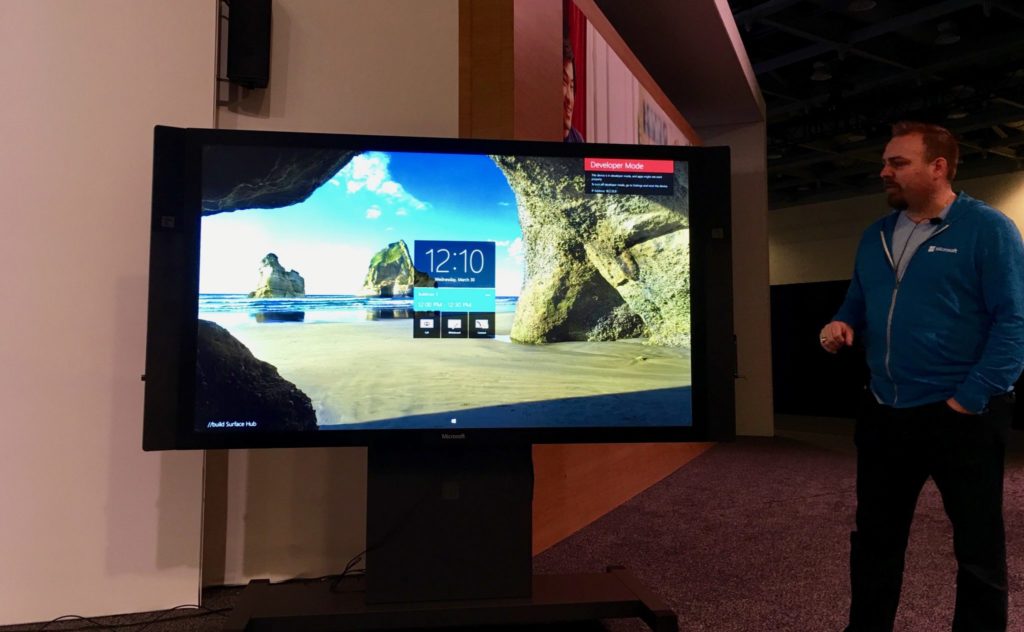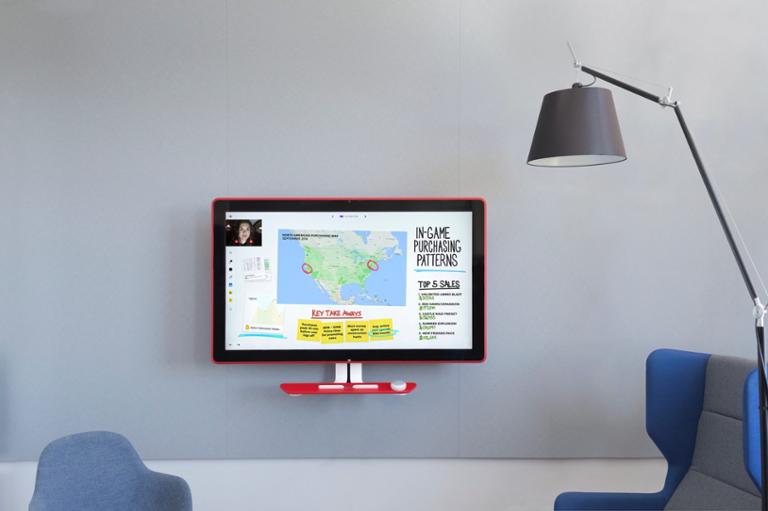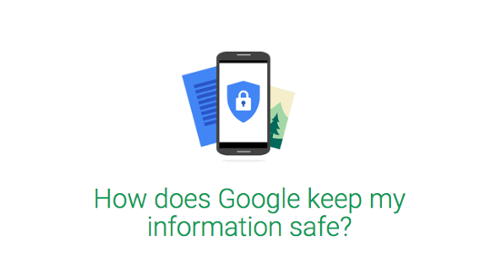
A whiteboard is nothing fancy, but it gets the job done. A team armed with erasable markers can use it to plot out everything from algorithms to UX. Take a photo of your work, and you can preserve it for all time. Google’s new Jamboard is an attempt to fancy up the traditional whiteboard. It costs $5,000, measures 55 inches across, and comes with a “specially designed” stylus and eraser that never need recharging. It understands the difference between finger and stylus input, meaning you can use the former to erase things. And because it’s stuffed with electronics (including Wi-Fi, Bluetooth, NFC, microphones, and HDMI), the Jamboard can deliver all sorts of gee-whiz features such as clipping content from the Web, inserting a Google Doc, or slapping on a pre-made sticker. Jamboards can also display content from other, remote Jamboards, transforming it into a collaboration tool. In many ways, the Jamboard seems like a direct competitor to Microsoft’s Surface Hub, another massive screen with stylus and conferencing support. Here's a look at the Hub from Build 2016: [caption id="attachment_141868" align="aligncenter" width="1024"]

Surface Hub Build 2016[/caption] The big question is: do most tech pros need a massive screen with a billion features when a simple board will do? The whiteboard’s “killer feature” is its simplicity. No fussing with Wi-Fi passwords or meeting times, no worrying whether a Google Doc will import, no troubleshooting a stylus: you just uncap your erasable marker, write out your equation or draw your wireframe, and your concept is conveyed to whomever’s in the room. You can leave content on a whiteboard for weeks, months, or even years without worrying that the device will power down or somehow not save your work. And perhaps best of all, it’s instantaneous: rather than wait for hardware to boot up, you can uncap and write down your thoughts before they escape your head. Indeed, the Jamboard and the Surface Hub seem less suited for tech pros in the midst of building an app or website, and more for executives who need to deliver an awe-inspiring presentation. These are C-suite tools, not something that a scrappy startup is going to use to diagram out their version of a Google Killer. No matter how high-tech things get, a lot of tech pros out there will continue to rely on good old-fashioned dry-erase.
 A whiteboard is nothing fancy, but it gets the job done. A team armed with erasable markers can use it to plot out everything from algorithms to UX. Take a photo of your work, and you can preserve it for all time. Google’s new Jamboard is an attempt to fancy up the traditional whiteboard. It costs $5,000, measures 55 inches across, and comes with a “specially designed” stylus and eraser that never need recharging. It understands the difference between finger and stylus input, meaning you can use the former to erase things. And because it’s stuffed with electronics (including Wi-Fi, Bluetooth, NFC, microphones, and HDMI), the Jamboard can deliver all sorts of gee-whiz features such as clipping content from the Web, inserting a Google Doc, or slapping on a pre-made sticker. Jamboards can also display content from other, remote Jamboards, transforming it into a collaboration tool. In many ways, the Jamboard seems like a direct competitor to Microsoft’s Surface Hub, another massive screen with stylus and conferencing support. Here's a look at the Hub from Build 2016: [caption id="attachment_141868" align="aligncenter" width="1024"]
A whiteboard is nothing fancy, but it gets the job done. A team armed with erasable markers can use it to plot out everything from algorithms to UX. Take a photo of your work, and you can preserve it for all time. Google’s new Jamboard is an attempt to fancy up the traditional whiteboard. It costs $5,000, measures 55 inches across, and comes with a “specially designed” stylus and eraser that never need recharging. It understands the difference between finger and stylus input, meaning you can use the former to erase things. And because it’s stuffed with electronics (including Wi-Fi, Bluetooth, NFC, microphones, and HDMI), the Jamboard can deliver all sorts of gee-whiz features such as clipping content from the Web, inserting a Google Doc, or slapping on a pre-made sticker. Jamboards can also display content from other, remote Jamboards, transforming it into a collaboration tool. In many ways, the Jamboard seems like a direct competitor to Microsoft’s Surface Hub, another massive screen with stylus and conferencing support. Here's a look at the Hub from Build 2016: [caption id="attachment_141868" align="aligncenter" width="1024"]  Surface Hub Build 2016[/caption] The big question is: do most tech pros need a massive screen with a billion features when a simple board will do? The whiteboard’s “killer feature” is its simplicity. No fussing with Wi-Fi passwords or meeting times, no worrying whether a Google Doc will import, no troubleshooting a stylus: you just uncap your erasable marker, write out your equation or draw your wireframe, and your concept is conveyed to whomever’s in the room. You can leave content on a whiteboard for weeks, months, or even years without worrying that the device will power down or somehow not save your work. And perhaps best of all, it’s instantaneous: rather than wait for hardware to boot up, you can uncap and write down your thoughts before they escape your head. Indeed, the Jamboard and the Surface Hub seem less suited for tech pros in the midst of building an app or website, and more for executives who need to deliver an awe-inspiring presentation. These are C-suite tools, not something that a scrappy startup is going to use to diagram out their version of a Google Killer. No matter how high-tech things get, a lot of tech pros out there will continue to rely on good old-fashioned dry-erase.
Surface Hub Build 2016[/caption] The big question is: do most tech pros need a massive screen with a billion features when a simple board will do? The whiteboard’s “killer feature” is its simplicity. No fussing with Wi-Fi passwords or meeting times, no worrying whether a Google Doc will import, no troubleshooting a stylus: you just uncap your erasable marker, write out your equation or draw your wireframe, and your concept is conveyed to whomever’s in the room. You can leave content on a whiteboard for weeks, months, or even years without worrying that the device will power down or somehow not save your work. And perhaps best of all, it’s instantaneous: rather than wait for hardware to boot up, you can uncap and write down your thoughts before they escape your head. Indeed, the Jamboard and the Surface Hub seem less suited for tech pros in the midst of building an app or website, and more for executives who need to deliver an awe-inspiring presentation. These are C-suite tools, not something that a scrappy startup is going to use to diagram out their version of a Google Killer. No matter how high-tech things get, a lot of tech pros out there will continue to rely on good old-fashioned dry-erase. 


